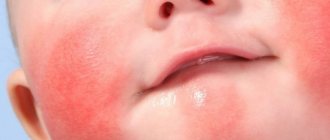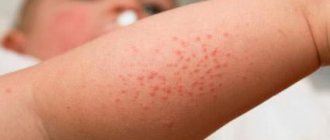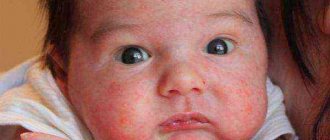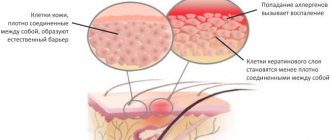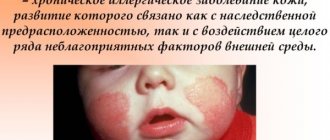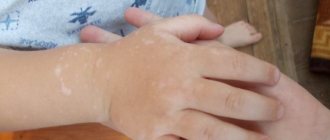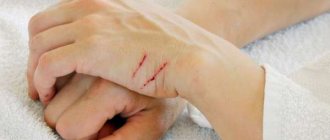Diaper dermatitis is popularly called diaper rash. Appears in newborns and infants on the genitals, in the buttocks, and on the inner thighs. Wet diapers and nappies are irritating factors. The disease causes great discomfort to the child, which is why he is capricious all the time and sleeps restlessly. The initial stage of the disease does not require the use of drugs; it is enough to carry out a hygienic procedure using baby cream and give the child an air bath. In advanced cases, conventional creams do not help.
Causes
The main cause of diaper dermatitis is a violation of the rules of hygienic care for the baby.
Inflammation affects the areas of the skin that are under the diaper, because it is in this area that conditions for skin injury are created . The negative effect consists of the following factors:
- physical - increased temperature and humidity under diapers;
- chemical - aggressive influence of urine components (uric acid, ammonia) and feces (enzymes, bilirubin) on the skin;
- mechanical - friction due to incorrectly selected diaper;
- biological - increased reproduction of opportunistic flora (fungi, cocci).
This is facilitated by the slight vulnerability of the epidermis of newborns due to the insufficiently developed protective function of the skin.
Some children are predisposed to the development of diaper dermatitis due to the characteristics of metabolic processes, increased ammonia content in the urine, and increased skin sensitization to external irritants.
Provoking factors:
- rare diaper changes;
- artificial feeding, in which feces have high enzymatic activity;
- diarrhea;
- antibiotic treatment causing dysbacteriosis;
- atopic, seborrheic dermatitis;
- incorrectly selected cosmetics for baby care: gels, creams, ointments, powders, wet wipes.
What is diaper dermatitis like?
As practice shows, this disease can be local in nature, affecting only certain small areas.
Related article:
Treatment of dermatitis during pregnancy
As a result, diaper dermatitis can be divided into the following groups::
- dermatitis affecting the folds of the neck (the result of frequent regurgitation of the child);
- perianal dermatitis (inflammatory process of the anus, the result of enzymatic activity of feces and dietary habits);
- isolated damage to the genital organs (the result of the peculiarities of the enzyme composition of urine);
- dermatitis of the inguinal folds.
Most often, diaper dermatitis manifests itself in the diaper area in the form of:
- abrasions : with proper treatment, the disease goes away without a trace;
- seborrheic dermatitis : characterized by a bright red color followed by the formation of yellow scales. After the diaper area is affected, the disease moves up the child’s body;
- marginal dermatitis : a consequence of rubbing the skin with the edges of the diaper;
- candidal dermatitis : manifests itself against the background of long-term use of antibiotics. The formation of a bright red rash in the groin area is characteristic;
- atopic dermatitis : can occur on different parts of the body and spread to the diaper area. The main symptom is severe itching;
- intertrigo : the result of skin rubbing against skin. If urine comes into contact with the abraded area, the dermis may become inflamed and covered with a yellow substance;
- Impetigo : Staphylococcal dermatitis affecting the diaper area. May be accompanied by blisters (bullous type) or scars with a yellowish crust (non-bullous type). It most often affects the thighs, lower abdomen and buttocks.
To accurately diagnose the disease and its subtype, a specialist will need a simple clinical examination without additional diagnostic procedures . A smear to determine the composition of the microflora may be required only if the disease lasts for a long time.
diaper dermatitis photo
Symptoms
In newborns and infants, clearly demarcated redness and swelling appear around the anus, on the skin of the genitals and adjacent areas, in large folds (intergluteal, inguinal). The surface of the red spots is smooth, shiny, and may be covered with a whitish or creamy coating.
If left untreated, the inflamed skin becomes covered with cracks, papular rashes appear in the folds, and maceration occurs . The child experiences pain and cries, especially after urination and defecation. But there are no symptoms of intoxication, the general condition suffers little.
How does diaper dermatitis manifest?
At the initial stage of diaper dermatitis, the baby exhibits abrasions and redness in the area:
- inguinal folds;
- hips;
- genitals;
- buttocks
Experts consider the formation of diaper rash to be the first stage of the disease.
Related article:
Atopic dermatitis in infants - how to treat a newborn baby?
If the necessary measures are not taken in time, the process will begin to progress and be supplemented by such manifestations as:
- wounds;
- red spots;
- erosion;
- small papules;
- peeling;
- bubbles with cloudy liquid contents;
- crusts.
Dermatitis can cause great discomfort to the baby , as a result of which the child becomes capricious and often cries.
Complications
The course of diaper dermatitis is benign, but with a weakened immune system, when a secondary infection develops, the deep layers of the dermis are affected. Pyogenic microbes penetrate deep into the subcutaneous tissue with the formation of purulent infiltrates, abscesses, and phlegmons.
With candidal inflammation, areas of hyperemia are covered with a grayish-whitish film or plaque, which, when removed, reveals an eroded surface.
Consultation with a doctor is necessary if your child:
- the temperature rises to 39 ° C;
- swelling will occur in the area of the affected skin;
- the skin acquires a bluish tint;
- when touching a sore spot, the child screams;
- pustular elements appear on the skin;
- the inguinal lymph nodes enlarge.
These are signs of complications of pathology and symptoms of the development of an infectious process.
What is diaper dermatitis?
Diaper dermatitis is an inflammatory reaction of the baby's epithelium under the influence of mechanical, physical and chemical microbial factors. Girls who are breastfed are most susceptible to this disease.
According to statistics, diaper dermatitis affects about 60 percent of all newborns .
Diaper dermatitis can cause discomfort to a child from the moment he is born until he reaches the age of three. The course of the disease depends on the nature of nutrition and individual characteristics of the skin.
Therapy
Treatment begins, first of all, with improving baby’s skin care:
- daily bathing;
- washing with warm water after changing diapers and after each urination and defecation;
- air baths.
Medicines
For diaper dermatitis, it is sufficient to use external agents in the form of ointments, creams, and gels. Depending on the predominance of certain inflammatory elements, appropriate medications are selected.
- For oozing and maceration in folds, zinc-containing ointments (Valiskin, Sudocrem, Tsindol, Zinc ointment) are applied to cleansed skin 2 times a day. The main active ingredient of these products is zinc oxide, which has a drying effect on the skin, relieves inflammation and swelling. Treatment is carried out for no more than 7 days.
- For newborns, Pantestin gel is a good remedy against diaper rash. This is a combination drug: it includes D-Panthenol and Miramistin. It has an antiseptic, anti-inflammatory, fungicidal effect.
- D-Panthenol and Bepanten, produced in the form of ointment, cream, spray, are drugs that promote regenerative processes in the skin. The ointment is quickly absorbed and has an anti-inflammatory and healing effect. Treat problem areas after bathing and washing the baby.
- An effective cream for diaper dermatitis, Drapolen, is used for both treatment and prevention. Has softening and antiseptic properties.
- Ointment for children Biolan. Contains panthenol with zinc oxide. The ointment dries and softens the skin under diapers.
Traditional methods
A necessary condition for using folk remedies is to check for the absence of hypersensitivity of the child’s skin to certain components.
- Decoctions and infusions of chamomile, calendula, oregano, mint, and string have anti-inflammatory and healing properties. Recipe for making an infusion: pour a tablespoon of dry herb (any) into a container with 200 ml of boiling water. Leave for an hour, strain and use to wipe problem areas or add to bathing water.
- Pour 200 ml of boiling water into 40 g of ground oat grain. After 30 minutes, strain and add to bathing water.
- Pour 40 g of St. John's wort into a container with 20 ml of olive oil. Keep in a water bath for 1 hour. Wipe affected areas after bathing every day.
Diagnostics
Diaper rash and diaper dermatitis are common cases in pediatric practice, so the diagnosis is made based on a physical examination, characteristic symptoms, and also after identifying the causes that provoke the development of the disease.
Laboratory tests (smear microscopy, bacteriological culture of contents from erosions) are carried out in difficult cases during differential diagnosis with other childhood dermatoses: allergic, contact, atopic, seborrheic.
The presence of other dermatological pathologies does not exclude the development of diaper dermatitis against their background.
Prevention
Preventive measures to prevent the development of diaper dermatitis include:
- Keeping your baby's skin dry and clean.
- Change the diaper at least every 3 hours.
- Air baths - leave the child naked or expose the lower half of the body for 20-30 minutes.
- Some parents raise their children in diapers, fearing the negative effects of diapers on the baby's health. In this case, you cannot use oilcloths at the same time as diapers, which create a greenhouse effect on the body, and diaper dermatitis develops even faster in them.
- Do not use alkaline detergents (soap), which dissolve the protective lipid film on the skin, causing it to become dry and easily crack.
- The use of high-quality disposable diapers, in which liquid is absorbed in the middle layer, and the skin remains dry for a long time.
- To prevent diaper rash, do not overheat the baby, use Zinc ointment after each bath on the skin covered with a diaper.
- To care for your baby, use only hypoallergenic baby cosmetics.
Diaper dermatitis is a widespread disease. Almost every baby experiences diaper rash on the skin. But timely treatment, good hygiene care and prevention of complications will help parents raise a healthy child.
What are the stages of diaper dermatitis?
Experts distinguish three main stages of the disease:
- violation of the protective function of the stratum corneum;
- loss of barrier function against infectious pathogens;
- normalization of the condition of the epidermis.
In the case of a prolonged course of the disease, complications may occur, including infection of the skin.
As a result, an addition to diaper dermatitis can be:
- abscess;
- infiltrate;
- candidal dermatitis.
In case of complications of the disease, the baby experiences an increase in temperature, decreased appetite and sleep disturbances.
Diaper dermatitis - video
Forms and varieties of the disease
When diagnosing, the type of rash, its severity and location are taken into account. Depending on these factors, there are several forms of diaper dermatitis:
- Scuffs. In this case, the skin turns red only in the place where it rubs against clothing or diaper material. If you react in time and take some measures, the red spots disappear on their own after a few days.
- Intertrigo. In this case, small red spots form on the skin, which in most cases are localized on the skin folds in the thighs and buttocks. This form of the disease is quite rare and is associated with increased humidity and friction of the skin.
- Perianal dermatitis. Foci of inflammation form on the skin around the anus. This form of the disease is associated with diarrhea, as well as changes in the acidity and chemical composition of stool.
- Regional dermatitis. In this case, the rash appears only in those places where the skin rubs against the edges of the diapers.

